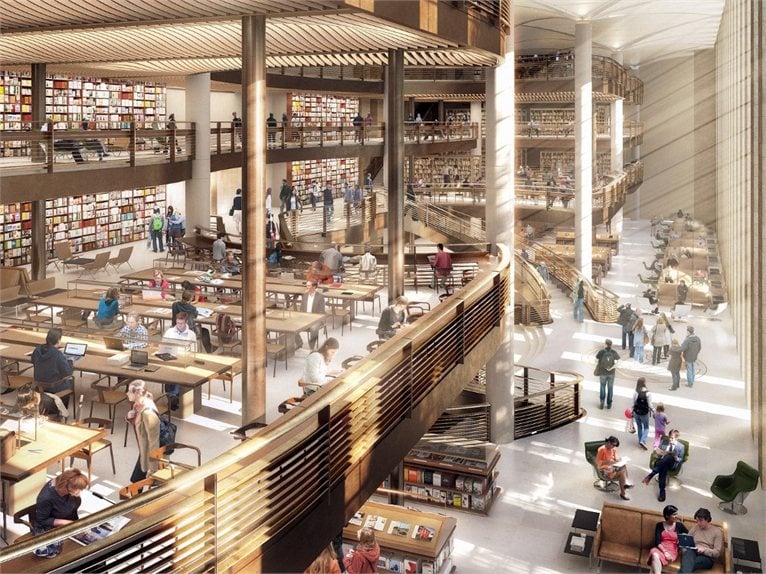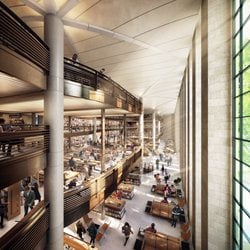
21/12/2012 - The New York Public Library unveiled yesteday proposals for the integration of the Circulating Library into its flagship Stephen A. Schwarzman Building on 42nd Street – Lord Norman Foster presented the plans at the launch of the public exhibition.
The project aims to safeguard the building’s legacy and precious books for future generations. The existing research library will be retained as it is today, with more space for researchers, as will many of the public spaces – the project will open twice as much of the building to the public and will restore the logic of the Neo-Classical design to improve the experience of the library’s historic halls. The two circulating collections will be housed in a spectacular new space previously occupied by book stacks.
The centrepiece of the 5th Avenue and 42nd Street building is the magnificent Rose Reading Room, below which are seven storeys of book stacks. However, these stacks are inaccessible to the public and no longer meet the needs of the books they contain, in terms of capacity, fire safety or preservation. The books will be moved to a large humidity-controlled chamber under Bryant Park, which was created in 1989 as part of the Bryant Park project, and provides the ideal environment for their conservation. Thus the stack space is freed to create a new ‘library within a library’ comprised of the Mid-Manhattan collections and the Science, Industry and Business Library – reinstating a circulating library to the NYPL main building, as had originally existed until the 1980s.
The 13,000 structural points of the existing stacks will be replaced with an innovative new vaulted stone and steel cradle. This move will free the floors from the west façade, allowing them to be peeled back to form a series of balconies – in the process revealing the full height of the slender windows internally for the first time. New study areas will line the perimeter of the balconies and new reading platforms will sit beneath the vaulted ceilings, which are carefully attuned to ensure excellent acoustic performance. The materials palette and design of the interiors will evolve with further development. The current combination shows bronze, wood and stone, which will age gracefully with the passage of time and use.
A new internal atrium runs the full length of the base of the circulation library, connecting the visitor facilities to the building’s accessible entrance on 42nd Street. Just 30 percent of the library is currently accessible to the public – the project will more than double this, opening 66 percent of the building by utilising unused reading rooms, back of house spaces, offices and book stacks. The design aims to make the building more inviting, more permeable and to bring the books to the fore rather than hide them away. Starting with the circulation strategy, the central axis through the Neo-Classical building will be reasserted.
Visitors will be able to walk in a straight line through the grand Fifth Avenue portico and the majestic Astor Hall into Gottesman Hall, where a permanent treasures gallery will display some of the most important pieces from the collection. For the fist time, the westerly doors of the Gottesman Hall will be opened up, restoring a sense of symmetry and intuitive circulation across the building. Visitors will enter the new circulation library on a balcony in the centre of the former book stack space, where they will face elevated views of Bryant Park. From here, a grand staircase will sweep down to the main level, aligned with the park, and further to the state-of-the-art education and business library below.
Lord Foster:
“We are reasserting the Library’s main axis and its very special sequence of spaces, from the main Fifth Avenue entrance and the Astor Hall, through the Gottesman Hall, into the dramatic volume of the new circulating library, with views through to the park. Our design does not seek to alter the character of the building, which will remain unmistakably a library in its feel, in its details, materials, and lighting. It will remain a wonderful place to study. The parts that are currently inaccessible will be opened up, inviting the whole of the community—it is a strategy that reflects the principles of a free institution upon which the library was first founded”.



 52
52
comment